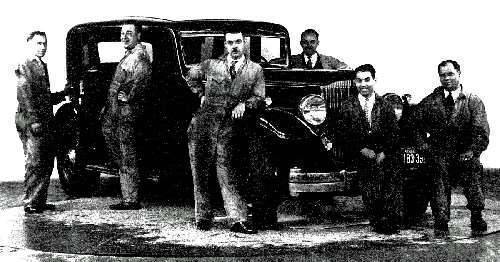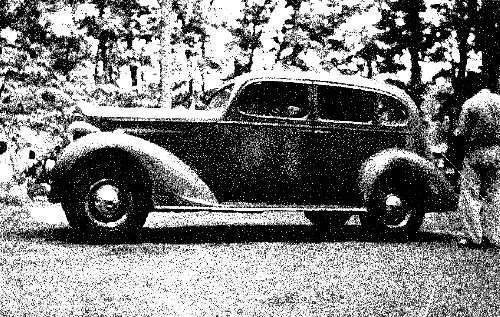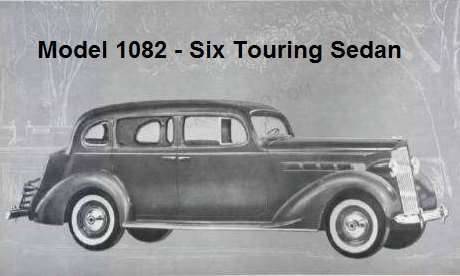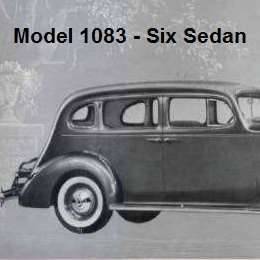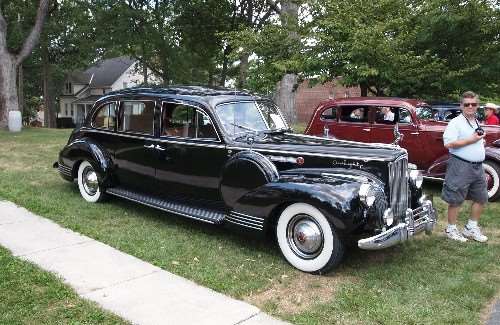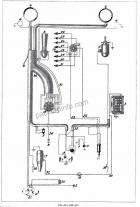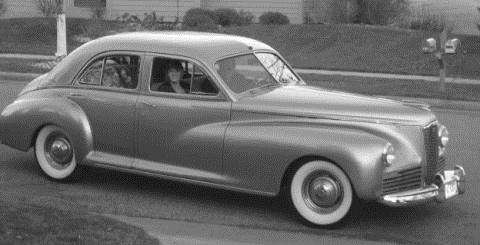|
Re: Remains of a 1937 prototype?
|
||||
|---|---|---|---|---|
|
Home away from home
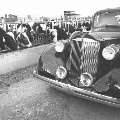
|
Cool!
 
Posted on: 2015/1/26 15:14
|
|||
|
I can explain it to you but I can't understand it for you
 Bad company corrupts good character! Farming: the art of losing money while working 100 hours a week to feed people who think you are trying to kill them |
||||
|
||||
|
Re: Remains of a 1937 prototype?
|
||||
|---|---|---|---|---|
|
Forum Ambassador
|
Roger,
Just read your article in the January/February 2015 issue of the Packard Digest, it's great! And if you do head off to look at the car, and it's worth saving in whole or part, what are the chances it could end up at the PPG?
Posted on: 2015/2/5 19:13
|
|||
|
Mal
/o[]o\ ====  Bowral, Southern Highlands of NSW, Australia "Out of chaos comes order" - Nietzsche. 1938 Eight Touring Sedan - SOLD 1941 One-Twenty Club Coupe - SOLD 1948 Super Eight Limo, chassis RHD - SOLD 1950 Eight Touring Sedan - SOLD What's this?  Put your Packard in the Packard Vehicle Registry! Here's how! Any questions - PM or email me at ozstatman@gmail.com |
||||
|
||||
|
Re: Remains of a 1937 prototype?
|
||||
|---|---|---|---|---|
|
Home away from home

|
Hello Mal:
That is a VERY good question and the best answer I have for you is, "I don't know." First of all, it is in private hands and a long way from Utica (Shelby Township), MI. Next, we have do a "walkabout" and learn what has actually survived. As intriguing as it sounds we already have several gifts that need restoration. One is a towing dynamotor car and a V8 show car display chassis. And before we can get to restore them we need to raise funds just to keep the doors open to the PPG. The PPG annual operating budget is about $74,000 and that is with an ALL volunteer workforce. It takes that amount of money just to keep the utilities turned on, grass cut, insurance paid, etc. On the other side of the coin we took in $32,500 in rental income from the Repair Garage to help offset those costs. The remaining $41,500 came from donations. After paying operating expenses any remaining donated funds are used to preserve and renovate the buildings. Our next goal is to complete work on the Repair Garage by installing a fire suppression system, adding heat and air-conditioning and complying with safety codes. That will cost about $275,000, but it will allow us to generate over $100,000 a year in rental income. Once the Repair Garage is complete we will then move onto the Engineering Building. Anyone wishing to become a "Friend of the PPG" can read more about it here: packardinfo.com/xoops/html/modules/newbb ... um=4&post_id=155378#forumpost155378 The more donations we receive the more we can do to save Packard history at the PPG. Thanks, --Roger--
Posted on: 2015/2/5 19:55
|
|||
|
||||
|
Re: Remains of a 1937 prototype?
|
||||
|---|---|---|---|---|
|
Home away from home

|
I mentioned in an earlier post that I would reproduce an article about my discussions with Jared Kowalewsky regarding his great-grandfather's prototype 1937 Packard. I have NOT repeated the photos that Jared posted earlier, but I have added new photos that Jared sent to me.
I have discussed this find with noted Packard historian, Jim Balfour and he is convinced that the 115C *1* dataplate "definitely" makes this a prototype and "totally authentic." There will be additional conversations with Jared and more research done on this car. 1937 Packard Prototype Hidden in the Woods By: Jared Kowalewsky and Roger Luksik In early January I was reading on the PackardInfo.com forum and noticed a posting from a guy in Lansing, Michigan asking about a "prototype" Packard his great grandfather owned. As I began reading I thought "yeah, sure - another family legend that cannot be true." I thought that until I read the last sentence of his post. Read for yourself: I am interested in sharing a story about a certain Packard car in my family. I don't have the good fortune of "owning" a Packard myself, but I did grow up with this "car in the woods" that captured my imagination as a small kid. I am hoping some of you fine folks might be able to expand my knowledge of it. I knew this as my grandma's car. Her father worked at Packard for most of his career, mainly as an engine mechanic and somewhat of a test driver. I have always heard the story of this car being a prototype, with a feature that was never put into production. Specifically, the rear of the car does not have a trunk that bumps out. Instead the rear is a slope, much like a 37 Ford, with the trunk tucked away behind the rear seat. The story goes that my great-grandfather saved the car from being destroyed and purchased it for a nominal fee. The car then served the family for close to 20 years as a functioning driver. Here the story takes a sad turn. In 1956, according to the story, the car was driven out on the family property and left. It has been inconceivable to me in retrospect, but perhaps that's just what you were supposed to do with things you didn't want anymore. In the time since, much of it before I was born, the car has succumbed to vandalism, fallen trees, sinking in the ground and plain old rust from snow and rain. The car has always been referred to as a 1937 and it has an inline-6. After my grandmother passed away last year, I visited the car and did some more homework on it. I learned that 1937 was the first market reasons. The car was dubbed a 115 early on, or perhaps that name was interchangeable with the "Packard 6" name, until 1940 when the 110 label appeared for a while. Interestingly enough, the vehicle ID plaque does not have a typical VIN number on it. Instead, it is stamped "115 C (star shape) 1 (star shape)". I'd love to hear from anybody who can shed more light on the subject. That photo changed everything for me. I was so impressed that I decided to call the guy and introduce myself. That is when I met Jared Kowalewsky and he shared his story with me. Jared's great-grand father was Lawrence Gitschlag and he worked as an engine mechanic for Packard. Lawrence's daughter Betty (Jared's grandmother) also ended up working at Packard during the war years as a secretary on East Grand Boulevard. Grandma Betty always mentioned that Packard was a great place to work and was very proud of the work her father did at Packard. As our discussion progressed I became convinced that Jared's story was true albeit with a few minor inconsistencies about the car. Yes, it is a prototype - the first one down the line. However, this model was put into production in 1937 and is known as body model #1083 a Six Sedan. It is a very close cousin to model #1082 - a Six Touring Sedan. The only difference between the two body styles is the "slant-back" trunk on Jared's sedan and the "bustle-back' trunk on Additionally, Grandma Betty wrote about the car: "1935 [7] Packard Six. Only two were made - this model was scrapped [i.e. not produced]- my dad got one and another man in Experimental got the other. The trunk was flat with a kind of a "hatch back" door. I still have the radiator ornament & the blue lens from the tail light." More research will be done on the car and great-grandpa Lawrence Gitschlag working at Packard. Stay tuned for further developments. Photo Caption: Lawrence Gitschlag is shown second from the left leaning against the door of this 1932 or 33 Packard Twelve. Notice the car is sitting on a round turntable which leads me to believe this was a posed photo from PMCC. Jared still retains the purple-dot tail light lens from this Packard.
Posted on: 2015/2/5 20:33
|
|||
|
||||
|
Re: Remains of a 1937 prototype?
|
||||
|---|---|---|---|---|
|
Forum Ambassador

|
Though not as common as the 1082-style sedans, the "slant-back" touring sedans in both junior and senior versions are around to be seen. The late Paul Kelley of CT had a lovely 36 senior Eight in that style with artillery wheels and here's a photo of a junior example (a 1936?), taken by this writer at the PAC Gettysburg National Meet. Although the two-tone paint is incorrect, it's a lovely example.
Attach file:  (34.01 KB) (34.01 KB)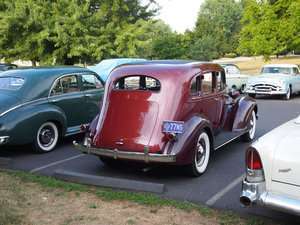
Posted on: 2015/2/6 9:45
|
|||
|
||||
|
Re: Remains of a 1937 prototype?
|
||||
|---|---|---|---|---|
|
Home away from home

|
Could it be a 35 O_D? It got junior fenders and looks like suicide doors in the front.
Posted on: 2015/2/6 12:14
|
|||
|
I can explain it to you but I can't understand it for you
 Bad company corrupts good character! Farming: the art of losing money while working 100 hours a week to feed people who think you are trying to kill them |
||||
|
||||
|
Re: Remains of a 1937 prototype?
|
||||
|---|---|---|---|---|
|
Forum Ambassador
|
Guy in our Packard club commented:
"Loved the article regarding the 1937 Packard 115C prototype discovered in northern Michigan - Stamped "115C #1" on ID plate; looks to me to be a 1936 body (shallower windscreen) they used for their six cylinder 115C prototype" If that's correct, that '36 had a shallower windscreen than '37, then it would reinforce that it is a prototype.
Posted on: 2015/2/6 14:11
|
|||
|
Mal
/o[]o\ ====  Bowral, Southern Highlands of NSW, Australia "Out of chaos comes order" - Nietzsche. 1938 Eight Touring Sedan - SOLD 1941 One-Twenty Club Coupe - SOLD 1948 Super Eight Limo, chassis RHD - SOLD 1950 Eight Touring Sedan - SOLD What's this?  Put your Packard in the Packard Vehicle Registry! Here's how! Any questions - PM or email me at ozstatman@gmail.com |
||||
|
||||
|
Re: Remains of a 1937 prototype?
|
||||
|---|---|---|---|---|
|
Forum Ambassador

|
For whatever benefit it might be, here's another view of the "slant back" 120 at Gettysburg showing the front windscreen.
Posted on: 2015/2/6 14:25
|
|||
|
||||
|
Re: Remains of a 1937 prototype?
|
||||
|---|---|---|---|---|
|
Home away from home

|
That maroon 120 is definitely a 1935
Posted on: 2015/2/6 14:41
|
|||
|
I can explain it to you but I can't understand it for you
 Bad company corrupts good character! Farming: the art of losing money while working 100 hours a week to feed people who think you are trying to kill them |
||||
|
||||

